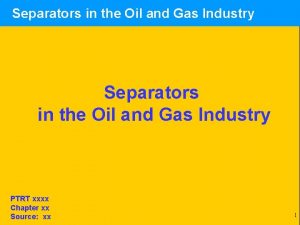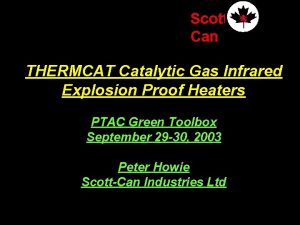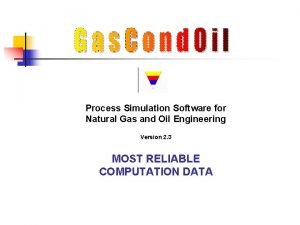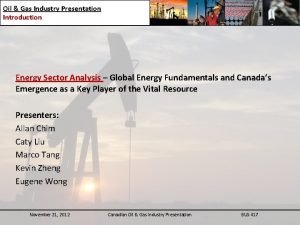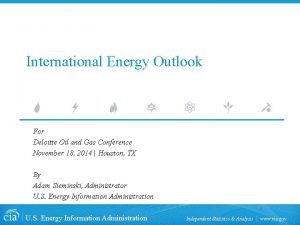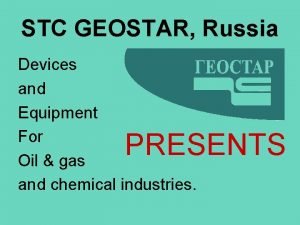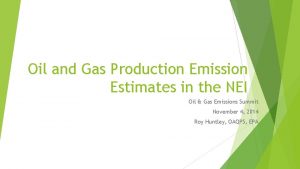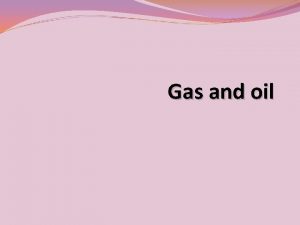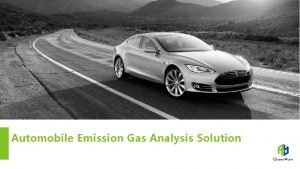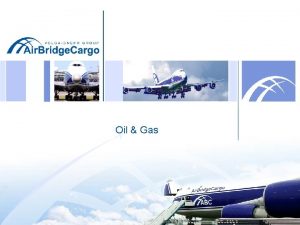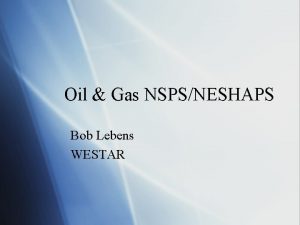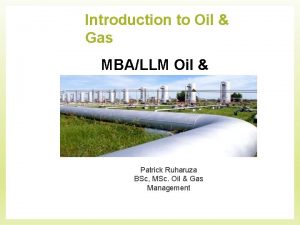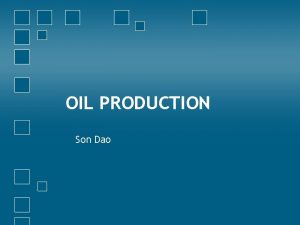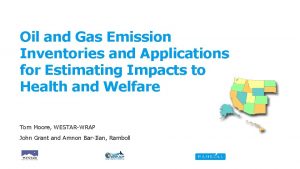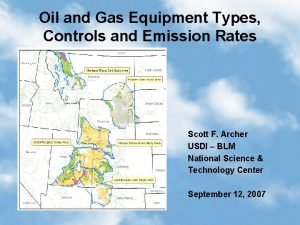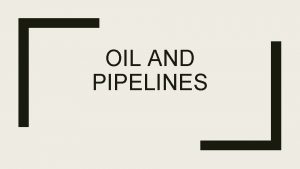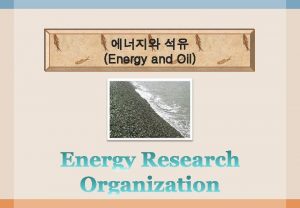Oil and Gas Production Emission Estimates in the

















- Slides: 17

Oil and Gas Production Emission Estimates in the NEI Oil & Gas Emissions Summit November 4, 2014 Roy Huntley, OAQPS, EPA

Today NEI – brief description Oil & Gas Estimation Tool Beginnings Features Results for 2011 NEI Opportunities for improvements

National Emissions Inventory (NEI) The full NEI is on a 3 -yr cycle (e. g. 2008, 2011, 2014) Point sources (facility-process for ~100, 000 facilities) Nonpoint and mobile sources (county-process) Fires (daily/point) Biogenic soil and vegetation (county) States, locals, and tribes are required to submit CO, SOX, NOX, VOC, PM 10, PM 2. 5, NH 3, and Lead. Basis is sections 110 and 172 of the Clean Air Act Use CAA-based emissions thresholds for “point. ” States can go lower. States can voluntarily submit Hazardous Air Pollutants (HAPs) and GHGs to the NEI EPA augments the data to make HAPs more complete GHGs are not published in the public release of the NEI Toxics Release Inventory helps 3

NEI Categories All emissions to the atmosphere included, whether regulated or unregulated, all counties Electric power plants and industrial sources Universities, hospitals, landfills, other commercial sources Residential heating, gasoline fueling stations, dry cleaners, household solvent use Farm animal waste, fertilizer, and agricultural burning On-road vehicles – exhaust, evaporative, brake and tire wear, paved and unpaved road dust Non-road engines – e. g. , farm equipment, mining equipment Aircraft, Ships, Railroads Wildfires and prescribed burning (forest management) Biogenics – soil and vegetation Some not included, notably: Volcanoes and other natural geothermal (SO 2, PM) Lightning NOx 4

Four Key NEI Goals Complete Represents Uses the year of the inventory best available information Transparent - includes the emissions origin (who provided, factor, activity, method) 5

NEI Timeline – example 2014 NEI Release reporting code updates and point EFs Opportunities to coordinate QA, Feedback, & Augment QA Use EPA Develop and release emissions tools/methods 2015 Emissions Year Ends Use and Review Prepare Emissions Industry Reports to SLT 2014 NEI v 1 Corrections & improvements 2016 SLT Submission Deadline 2014 NEI v 2 2017 States/Locals/ Tribes Review and Comment/Submit Review and Comment Industry 6

Oil and Gas Tool: History and Status

ERTAC’s National Oil & Gas Committee ERTAC (Eastern Regional Technical Advisory Committee) recognized need for development of national EPA emissions of criteria and HAP estimates First established for 2008 NEI Purpose: Develop NEI methodologies for estimates Established National Oil and Gas Committee, late 2011 Members, OAQPS/EIAG (Roy Huntley & Jennifer Snyder) RPOs and MJOs (Westar/WRAP (Tom Moore), MARAMA (Julie Mc. Dill), Cen. SARA (Theresa Pella), Mark Janssen (LADCO)), and many state/county emission inventory experts Prepared white paper regarding need for national estimates EPA funding/resources became available to develop tool in early 2012 8

Tool Development Based on estimation methodologies developed by Cen. SARA states are TX, OK, KS, NE, LA, AR, IA, MO We wanted to leverage the progress Cen. SARA had already made on estimation methodologies Technical approaches were sound and based on new data Includes data and methodologies from operator surveys, permit reviews, literature reviews, the Climate Registry, and previous studies, such as one for the Haynesville Shale in NE Texas and the WRAP phase III study for the Rocky Mountain Region – Basin Factors Expanded coverage to all states (not just Cen. SARA states) 9

Overview of Tool MS Access-based Creates county- and process-level detail for criteria and HAPs Needs to handle large amounts of data, inputs and outputs Ability to create front-end, user-friendly steps Portability/availability Transparent Combination of tables, queries, macros Logical grouping of tables and queries, use of message/instruction boxes Users can vary parameters by county or basin, as necessary Emission process selection Can run the tool on one or more of the processes Processes coded with 34 Source Classification Codes (SCC) 10

Oil & Gas Processes Covered by Tool Artificial lift engines Associated gas venting Condensate tanks Crude oil tanks Dehydrators Drilling rigs Flaring Fugitive leaks Gas-actuated pumps Heaters Hydraulic fracturing pumps Lateral compressors Liquids loading Liquids unloading Mud degassing Pneumatic devices Produced water tanks Well completions Wellhead compressors 11

Tool Data Sources Basin-specific Inputs (or county level) Equipment profiles - e. g. , number of dehydrators or lateral compressors per well Control profiles - e. g. , fraction of well completion flared and control efficiency Whole gas composition profiles (percent VOC, benzene, toluene, etc. ) Engine size, load, hours of operation Used state-provided factors where available, then EPA emission factors as defaults where available, then “Cen. SARA averages” when no better info available Activity Data: from state oil and gas commissions, state inventory offices, Drillinginfo/HPDI, trade associations, all at county level Well counts by type (oil, gas, CBM (coal bed methane)) Oil and natural gas production Produced water from oil, gas, and CBM wells Well completion counts by type Fraction of gas wells that need compression Fraction of oil wells that need lift Spud information (aka drilling starts) - directional (horizontal, vertical) and feet drilled 12

Tool Data Sources (continued) Emission factor data (i. e. , drilling & compressor engines, well completions) EPA (EPA’s GHG Reporting Program, AP-42, FIRE, SPECIATE, Equipment Leaks Protocol) API (American Petroleum Institute) ANGA (America’s Natural Gas Alliance) NONROAD model Other sources (e. g. , Cen. RAP (Central Region Air Planning Association), TCEQ (Texas Commission on Environmental Quality), Climate Registry) 13

Tool Outputs & Documentation Data exported in EIS (Emission Inventory System) format County-process-pollutant Converting emission data to EIS format traditionally has been a hurdle for state inventory submitters Point source subtraction User can subtract out point source contributions to prevent double counting Summary queries Basin factor and inputs activity glossaries Master references table in tool identifies sources of all input data Documentation of methodologies Directions on how to use tool 14

Oil and Gas NOx: 2008 versus 2011 NEI 2008 NEI >= 0 to <= 100 TPY >100 to <= 500 >500 to <= 2, 500 >2, 500 to <= 10, 000 >10, 000 15

Oil and Gas NOx: 2008 versus 2011 2008 NEI >= 0 to <= 100 TPY >100 to <= 500 >500 to <= 2, 500 >2, 500 to <= 10, 000 >10, 000 2011 NEI 16

 Post multimedia
Post multimedia Bread toasting: gas formation color change light emission
Bread toasting: gas formation color change light emission Pharmaceutical application of emulsion
Pharmaceutical application of emulsion Types of separators in oil and gas industry
Types of separators in oil and gas industry Catalytic heater oil and gas
Catalytic heater oil and gas Oil and gas process simulation software
Oil and gas process simulation software Introduction to oil and gas industry ppt
Introduction to oil and gas industry ppt Ibm maximo scheduler
Ibm maximo scheduler Maximo hse
Maximo hse Madagascar oil and gas
Madagascar oil and gas Deloitte oil and gas
Deloitte oil and gas Hitachi vantara oil and gas
Hitachi vantara oil and gas Risk management case study oil and gas industry
Risk management case study oil and gas industry Drops oil and gas
Drops oil and gas Uses of oil and gas
Uses of oil and gas Atb oil and gas
Atb oil and gas Echometer oil and gas
Echometer oil and gas Osu oil and gas accounting conference
Osu oil and gas accounting conference



